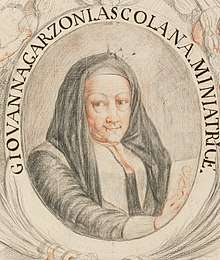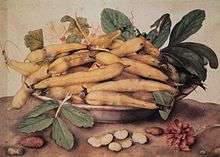Giovanna Garzoni
Giovanna Garzoni (1600–1670) was an Italian painter of the Baroque period. She began her career painting religious, mythological, and allegorical subjects but gained fame for her botanical subjects painted in tempera and watercolour.[2] Her works were praised for their precision and balance and for the exactitude of the objects depicted.[3] She was often called the Chaste Giovanna due to her vow to remain a virgin.[4] Scholars have speculated Garzoni may have been influenced by fellow botanical painter Jacopo Ligozzi[5] although details about Garzoni's training are unknown.

_-_Still_Life_with_Bowl_of_Citrons_-_Google_Art_Project.jpg)
Early life
Giovanna Garzoni was born in 1600 in Ascoli Piceno in the Marche district of Italy to Giacomo Garzoni and Isabetta Gaia.[6] Both of Garzoni's parents were of Venetian origin and are believed to have come from a long line of Venetian painters - a fact that is often disputed.[2] Garzoni's grandfather Nicola and Uncle Vincenzo from her mother's side were both goldsmiths while her other uncle, Pietro Gaia, was a painter who studied under Palma the Younger.[7] Historians have widely speculated that Garzoni started off her career as an apprentice under her uncle sometime before 1615. Garzoni also had a brother, Mattio, with whom she would travel throughout her career.[8]
Career
Garzoni's first known commission was in the city where she grew up, Rome. It was in 1616, from the chemist Giovanni Vorvino to paint a herbarium.[6] Four years later in 1620 Garzoni arrived in Venice and painted a Saint Andrew for the Venetian Church of the Ospedale degli Incurabili. Garzoni stayed in Venice for a few more years and during that time attended the Calligraphy school of Giacomo Rogni. Shortly after her studies, Garzoni produced a book of cursive characters called the Libro de'caratteri Cancellereschi Corsivi.[7]
After finishing her education, Garzoni and her brother Mattio left Venice in 1630 for Naples where she worked for the Spanish viceroy, the Duke of Alacala. Garzoni remained in Naples for a year before returning to Rome in 1631. Garzoni's stay in Rome was short lived however, due to Christina of France's persistent efforts to have the artist come to Turin to serve as the miniaturist for the Turinese court.[9] Garzoni reached Turin in 1632 and lived there until 1637. After staying in Turin, Garzoni became familiar with the work of fellow artists Fede Galizia and Panfilo Nuvolone.[10] A few years later in 1640, Garzoni arrived in Paris and stayed there until 1642 when she went to Rome. Garzoni traveled back and forth from Rome to Florence until 1651 where her primary clients were in the Medici Family, particularly Grand Duke Ferdinando II, Grand Duchess Victoria, and Cardinal Giovan Carlo.[11]
After serving the Medici Court, Garzoni decided to settle in Rome in 1651 where she worked continue producing work for the Florentine Court.[12] As well as painting, Garzoni attended the Accademia di San Luca, where she followed events and discussion aimed at educating, socializing, and professionalizing painters, architects and sculptors of Rome.[13] It is noted by several historians that Garzoni's pieces were so well received by the public; she was able to ask any price for her paintings.[14]
Notable works and clients

Plate with White Beans:
Plate with White Beans was one of the several works of art commissioned by the Medici family. The still life, painted sometime between 1650-1662, is a naturalistic study of beans in various stages of ripeness and decay. It is collection of the Galleria Palatina in Florence.[15]
Portrait of Carlo Emanuele I, Duke of Savory:
Created between 1623–1637 when Garzoni was invited to work for the court of Turin by Christina of France in 1632, this painting is now located in Palazzo Reale, Turin and was last restored in 1995.[16]
Still Life with a Basket of Fruit, a Vase with Carnations and Shells on a Table:
This gouache on vellum piece is one of the twenty still-life miniatures that Garzoni produced for the Medici family from the years 1650–1662. The piece depicts carnations, conch shells, as well as a basket of fruit. Due to her work for the Medici Court, Garzoni became a favorite within the Florentine court for her depictions of nature and botanical subjects. It is now located in the Wallace and Wilhelmina Holladay Collection in Washington, DC.[17]
Two important manuscript notebooks by Garzoni exist. The rare books library in Washington DC, Dumbarton Oaks, contains a self-portrait of the elderly artist, in addition to a number of botanical studies. Another album, held by the Accademia di San Luca, the artists' institute to which Garzoni left her estate, includes flower studies and still lifes.[18]
Personal life
It is believed by historians that Garzoni never married, but others speculate that the artist was once married to Venetian portrait painter Tiberio Tinelli in 1622.[19] If so, the marriage was short lived, possibly resulting in separation in 1624.[19]
Death
In 1666, Garzoni devised a will that left her estate to the Church of Santa Martina, the church of the Accademia di San Luca on the basis that she would be buried in the church. Garzoni died in Rome in February 1670 at the age of 70.[10] Today, Garzoni's tomb remains at the Church of Santa Martina but it was not interred there until 1698, nearly 29 years after her death. Roman painter Giuseppe Ghezzi's portrait of Garzoni is also located at the Accademia.[20]
References
- "Still Life with Bowl of Citrons (Getty Museum)". The J. Paul Getty in Los Angeles.
- Jordi Vigué. Great Women Masters of Art. (New York: Watson-Guptill, 2003), 77.
- Sheila McTighe. “Foods and the Body in Italian Genre Paintings, about 1580: Campi,Passarotti, Carracci”. The Art Bulletin, College Art Association 86 (2004):301–323,accessed October 23, 2014, doi 10.2307/3177419.
- Jane Fortune, and Linda Falcone.Invisible Women. (Florence: The Florentine Press, 2010), 101.
- "Giovanna Garzoni (Italian, 1600 - 1670) (Getty Museum)". The J. Paul Getty in Los Angeles.
- Jordi Vigué. Great Women Masters of Art. (New York: Watson-Guptill, 2003), 77.
- Carole Collier Frick, Stefania Biancani, and Elizabeth S. G. Nicholson. Italian Women Artists: from Renaissance to Baroque. (Milano: Skira, 2007), 220.
- Carole Collier Frick, Stefania Biancani, and Elizabeth S. G. Nicholson. Italian Women Artists: from Renaissance to Baroque. (Milano: Skira, 2007), 220–21.
- Carole Collier Frick, Stefania Biancani, and Elizabeth S. G. Nicholson. Italian Women Artists: from Renaissance to Baroque. (Milano: Skira, 2007), 221.
- Carole Collier Frick, Stefania Biancani, and Elizabeth S. G. Nicholson. Italian Women Artists: from Renaissance to Baroque. (Milano: Skira, 2007), 221.
- Carole Collier Frick, StefaniaBiancani, and Elizabeth S. G. Nicholson. Italian Women Artists: from Renaissance to Baroque. (Milano: Skira, 2007), 221.
- Carole Collier Frick, StefaniaBiancani, and Elizabeth S. G. Nicholson. Italian Women Artists: from Renaissance to Baroque. (Milano: Skira, 2007), 221.
- “The History of the Accademia di San Luca, c. 1590–1635: Archived from the Archivio di Stato di Roma”. National Gallery of Art. Accessed November 25, 2014. "Archived copy". Archived from the original on 2014-11-16. Retrieved 2014-12-16.CS1 maint: archived copy as title (link).
- “The Flowering of Florence: Botanical Art for the Medici”. National Gallery of Art. Accessed October 22, 2014. "Archived copy". Archived from the original on 2007-09-16. Retrieved 2007-01-27.CS1 maint: archived copy as title (link)
- Jordi Vigué. Great Women Masters of Art. (New York: Watson-Guptill, 2003), 79.
- Carole Collier Frick, Stefania Biancani, and Elizabeth S. G. Nicholson. Italian Women Artists: from Renaissance to Baroque. (Milano: Skira, 2007), 222.
- Carole Collier Frick, Stefania Biancani, and Elizabeth S. G. Nicholson. Italian Women Artists: from Renaissance to Baroque. (Milano: Skira, 2007), 238.
- Tongiorgi Tomasi, Lucia; Hirschauer, Gretchen A; National Gallery of Art (U.S.) (2002-01-01). The flowering of Florence: botanical art for the Medici. Washington, D.C.: National Gallery of Art. pp. 77–81. ISBN 0894682881. OCLC 48507800.
- Francesca Bottacin, Appunti per il soggiorno veneziano di Giovanna Garzoni: documenti inediti, in “Arte Veneta”, 52, 1998, pp. 141–147
- Jane Fortune and Linda Falcone. Invisible Women. (Florence: The Florentine Press, 2010), 103.
Sources
- Ferraro, Joanne M. Marriage Wars in Late Renaissance Venice. (New York: Oxford University Press, 2001).
- Fortune, Jane, and Linda Falcone. Invisible Women. (Florence: The Florentine Press, 2010).
- Frick, Carole Collier, Stefania Biancani, and Elizabeth S. G. Nicholson. Italian Women Artists: from Renaissance to Baroque. (Milano: Skira, 2007).
- McTighe, Sheila. Foods and the Body in Italian Genre Paintings, about 1580: Campi, Passarotti, Carracci. The Art Bulletin, College Art Association 86 (2004):301–323, doi 10.2307/3177419.
- Anon. The Flowering of Florence: Botanical Art for the Medici. National Gallery of Art. Accessed October 22, 2014. .
- The History of the Accademia di San Luca, c. 1590–1635: Archived from the Archivio di Stato di Roma. National Gallery of Art. .
- Vigué, Jordi. Great Women Masters of Art. (New York: Watson-Guptill, 2003).
External links
![]()
- Accademia of San Luca
- Giovanna Garzoni Getty Museum
- National Gallery of Art
- Web Gallery of Art (images)
- Cleveland Institute of Art
- Giovanna Garzoni Notebook: Garzoni, Giovanna, 1600–1670. Piante varie. ca. 1650. RARE RBR G-3-3. Dumbarton Oaks Research Library, Washington, DC
- CLARA Database of Women Artists